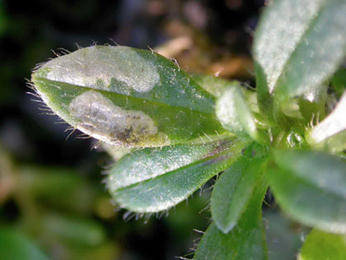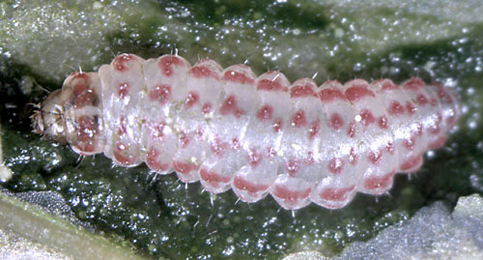|
||||||
|
AMARANTHUS. Pigweeds. [Amaranthaceae] |
|
About thirty-three species of Amaranthus are recorded in Britain, all of them introduced. They include White Pigweed (A. albus), Prostrate Pigweed (A. blitoides), Guernsey Pigweed (A. blitum), Indehiscent Amaranth (A. bouchonii), Cape Pigweed (A. capensis), Love-lies-bleeding (A. caudatus), Purple Amaranth (A. cruentus), Perennial Pigweed (A. deflexus), Short-petalled Pigweed (A. graecizans), Green Amaranth (A. hybridus), Prince's-feather (A. hypochondriacus), Dioecious Amaranth (A. palmeri), Powell's Amaranth (A. powellii), Mucronate Amaranth (A. quitensis), Common Amaranth (A. retroflexus), Indehiscent Pigweed (A. standleyanus) and Thunberg's Pigweed (A. thunbergii). The BSBI provide a downloadable plant crib for Amaranthus. Eight British miners are recorded on Amararnthus. A key to the European miners recorded on Amaranthus is provided in Bladmineerders van Europa. |
Key for the identification of the known mines of British |
Note: Diptera larvae may live in a corridor mine, a corridor-blotch mine, or a blotch mine, but never in a case, a rolled or folded leaf, a tentiform mine or sandwiched between two more or less circular leaf sections in later instars. Pupation never in a cocoon. All mining Diptera larvae are leg-less maggots without a head capsule (see examples). They never have thoracic or abdominal legs. They do not have chewing mouthparts, although they do have a characteristic cephalo-pharyngeal skeleton (see examples), usually visible internally through the body wall. The larvae lie on their sides within the mine and use their pick-like mouthparts to feed on plant tissue. In some corridor miners frass may lie in two rows on alternate sides of the mine. In order to vacate the mine the fully grown larva cuts an exit slit, which is usually semi-circular (see Liriomyza huidobrensis video). The pupa is formed within the hardened last larval skin or puparium and as a result sheaths enclosing head appendages, wings and legs are not visible externally (see examples). See Key to non-Diptera. |
1a > Leaf and stem miner: Eggs are scattered individually over the leaf upper surface; they are only loosely attached to the plant. The egg shell has a honeycomb structure. The larva begins with first mining one of the top leaves completely out. Next the larva moves down to another leaf, by way of a tunnel made in the stem. In this way several leaves are mined out, completely and full depth. In the attacked part of the plant the stem has become translucent; the damage causes the plant tip to wilt. In the first mines almost no frass is to be found, further down it is deposited in coarse grains. Pupation generally outside the mine (Miles, 1953). |
|
Delia echinata (Seguy, 1923) [Diptera: Anthomyiidae]. |
1b > Leaf-miner: Oviposition can take place in the leaf, where a short mine is formed. The young larva feeds towards the mid-rib and down into the stem. Alternatively a true mine can be formed in the stem before the larva burrows deeper into the pith. Pupation external. Puparium yellow |
|
Amauromyza chenopodivora Spencer, 1971 [Diptera: Agromyzidae]. |
1c > Leaf-miner: The mine starts as a long, narrow, winding corridor running towards the midrib, widening to a blotch. Usually upper-surface, but in small leaves also full-depth parts may occur. The blotch has broad lobes; in their ends most frass is accumulated in the form of green patches or clouds. Sometimes several larvae share mine. Pupation usually in the soil, less often in the leaf (and then generally not in the mine itself but in a small separated mine, that may even be made in the petiole). |
 Mine of Scaptomyza graminum on Cerastium glomeratum Image: © Jean-Yves Baugnée (Bladmineerders van Europaa) |
|
Scaptomyza graminum (Fallén, 1823) [Diptera: Drosophilidae]. |
1d > Leaf-miner: A short, irregular, linear upper surface mine on any part of the leaf. Also recorded from young pods (Bland, 1997a). Long corridor mine. As a rule the first part of the mine is lower-surface, the later part upper-surface. Often the loops are so dense that a secondary blotch is the result. Because upper- and lower-surface corridor segments often cross, the mine obtains a strange array of transparant patches. There is no association with the midrib. Frass in strings and thread fragments. Pupation outside the mine; exit slit in upper epidermis. Mine not associated with the veins or midrib of the leaf (It is this character which enables distinction from another Agromyzid pest species - Liriomyza huidobriensis). The larvae may leave one leaf (if not large enough) and enter another leaf, via the petiole). It exits the leaf to pupate through a semi-circular slit in the upper surface of the leaf. |
|
Liriomyza bryoniae (Kaltenbach, 1858) [Diptera: Agromyzidae]. |
1e > Leaf-miner: A distinctive mine primarily above mid-rib, with irregular short lateral offshoots into leaf blade. Pupation external (Spencer, 1972: 51 (fig. 172), 55; Spencer, 1976: 270, 271 (fig. 486)). Branched, whitish, upper-surface corridor; main axis overlying the midrib; side branches overlying the main lateral veins. (In Campanula and Phyteuma the mine is much less branched, sometimes nothing more than a corridor on top of the midrib). Frass in rather long strings. Usually the mines begins as a long and narrow, shallow, tortuous lower-surface corridor that ends upon the midrib but otherwise is not associated with the leaf venation. Often this initial corridor is filled with callus, and then even less conspicuous. Pupation outside the mine. A linear mine on the upper surface, usually following the midrib and showing side branches along the veins. The frass is in strings. |
|
Liriomyza strigata (Meigen, 1830) [Diptera: Agromyzidae]. |
1f > Leaf-miner: Mine linear, whitish, both upper and lower surface. Pupation internal, at the end of the mine with the anterior spiracles projecting through the epidermis (Spencer, 1976: 433). Upper-surface, less often lower-surface corridor. Frass in isolated grains. Pupation within the mine, in a, usually lower-surface, pupal chamber. A long whitish upper surface corridor, which eventually goes lower surface. |
|
Chromatomyia horticola (Goureau, 1851) [Diptera: Agromyzidae]. |
Key for the identification of the known mines of British |
Note: The larvae of mining Coleoptera, Hymenoptera and Lepidoptera may live in a corridor mine, a corridor-blotch mine, a blotch mine, a case, a rolled or folded leaf, a tentiform mine or sandwiched between two more or less circular leaf sections in later instars. Larva may pupate in a silk cocoon. The larva may have six legs (although they may be reduced or absent), a head capsule and chewing mouthparts with opposable mandibles (see video of a gracillarid larva feeding). Larvae of Hymenoptera and Lepidoptera usually also have abdominal legs (see examples). Frass, if present, never in two rows. Unless feeding externally from within a case the larva usually vacates the mine by chewing an exit hole. Pupa with visible head appendages, wings and legs which lie in sheaths (see examples). |
1a > Leaf-miner: The red and white larvae feed by mining the leaves forming a contorted gallery. A strongly contorted, often intestinine-like corridor, often forming a secondary blotch. Much green frass in broad arcs. Full grown larva mostly on top of the midrib. Pupation external. |
 Chrysoesthia drurella larva, dorsal Image: © Willem Ellis (Bladmineerders van Europa) |
|
Chrysoesthia drurella (Fabricius, 1775) [Lepidoptera: Gelechiidae]. |
1b > Leaf-miner: Whitish blotches in the leaves. The mine begins as a short zigzagging corridor, that very soon becomes overrun by a large, perfectly transparent blotch. Frass in a big black central lump. In fresh mines something like primary feeding lines are recognisable, normally seen only in Diptera mines. Pupation external, exit a rather untidy hole. A large, whitish blotch sometimes occupying most or all of the leaf. The frass is mostly ejected from the mine.. |
|
Chrysoesthia sexguttella (Thunberg, 1794) [Lepidoptera: Gelechiidae]. |
| Last updated 30-Jun-2019 Brian Pitkin | ||
